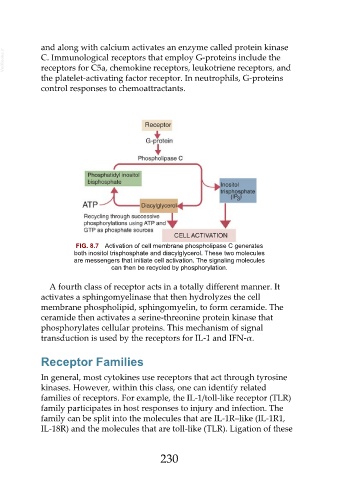Page 230 - Veterinary Immunology, 10th Edition
P. 230
and along with calcium activates an enzyme called protein kinase
VetBooks.ir C. Immunological receptors that employ G-proteins include the
receptors for C5a, chemokine receptors, leukotriene receptors, and
the platelet-activating factor receptor. In neutrophils, G-proteins
control responses to chemoattractants.
FIG. 8.7 Activation of cell membrane phospholipase C generates
both inositol trisphosphate and diacylglycerol. These two molecules
are messengers that initiate cell activation. The signaling molecules
can then be recycled by phosphorylation.
A fourth class of receptor acts in a totally different manner. It
activates a sphingomyelinase that then hydrolyzes the cell
membrane phospholipid, sphingomyelin, to form ceramide. The
ceramide then activates a serine-threonine protein kinase that
phosphorylates cellular proteins. This mechanism of signal
transduction is used by the receptors for IL-1 and IFN-α.
Receptor Families
In general, most cytokines use receptors that act through tyrosine
kinases. However, within this class, one can identify related
families of receptors. For example, the IL-1/toll-like receptor (TLR)
family participates in host responses to injury and infection. The
family can be split into the molecules that are IL-1R–like (IL-1R1,
IL-18R) and the molecules that are toll-like (TLR). Ligation of these
230

